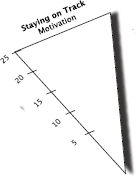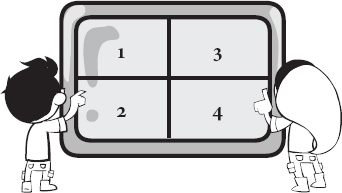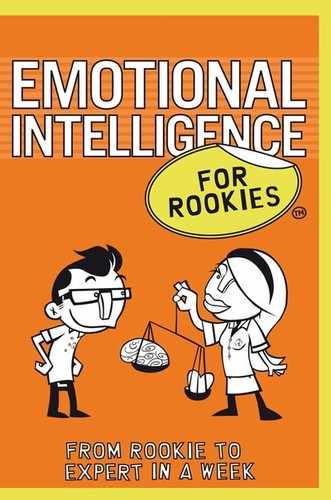CHAPTER 5
Staying on track
What is motivation?
In this chapter you will learn to:
• Plan your day and manage your natural energy reserves.
• Generate positive energy when your reserves are running low.
• Identify what makes you feel good and gives you a sense of fulfilment.
• Overcome distractions and stay present in the moment.
And the key to all this is motivation. But just what is motivation? Higgs and Dulewicz define it as “the drive and energy to achieve clear results and make an impact, and also to balance both short- and longterm goals with a capability to pursue demanding goals in the face of rejection or questioning”.
Take a moment to reflect on this definition.
• What is it saying to you?
• Which are the key words or phrases that stand out?
• Why are they important to you?
It’s about staying on track
In essence, motivation is about managing your energy and emotional state to achieve what you set out to do. It relies on your self-awareness in terms of knowing how you feel, whether you are in the right frame of mind for the task in hand, and whether you feel energized to keep moving ahead to get the job done.
 Rookie Buster
Rookie Buster
Motivation is about managing your energy and emotional state to achieve what you set out to do.
Motivation differs from emotional resilience in that your ability to keep going when things get tough is a matter of choice. You can choose to give up if it’s too much like hard work, or you can choose to draw on your inner reserves, fire yourself up with incentives and remind yourself of the real purpose and desired outcome.
When your motivation is low, it’s usually because your resources are running low, and you’ll need to replenish these and generate your own positive energy to move forward.
When your emotional resilience is low, it’s usually because you are overwhelmed by anxiety, anger or futility, and are literally disabled by your emotions.
Why is motivation important?
Your motivation and your ability to engage and inspire others is crucial in order to:
• Achieve your defined goals.
• Overcome any obstacles.
• Work with and through others.
Your motivation is underpinned by your energy. Energy levels will ebb and flow, but without energy you won’t have the physical strength, mental prowess or the right emotional state to be able to motivate yourself or others.
 Rookie Buster
Rookie Buster
Without energy you won’t have the physical strength, mental prowess or the right emotional state to be able to motivate yourself or others.
A highly motivated individual will:
• Show optimism and a positive attitude in the way they behave and the language they use.
• Have high levels of energy and drive.
• Set challenging goals – in both the short and the long term.
• Be focused on performance and achieving the goals.
• Continually look for ways to improve themselves as well as what they do.
• Overcome barriers, obstacles and personal challenge.
• Identify milestones and celebrate those once achieved.
• Engage and inspire belief in others.
• Regularly review their goals as a way of refocusing themselves and re-engaging others.
What can affect your motivation?
Your motivation can be affected by your:
• Energy and drive.
• Goal or purpose.
• Ability to overcome obstacles or distractions.
Creating your energy
Knowing where your energy comes from, when your body needs more energy and how you can use your energy most effectively in your daily routine is essential.
Energy can so easily be lost through dissipation, stimulants, tension and emotional or physical excess, as well as prolonged loss of sleep or rest. The more energy that you lose, the more likely it is that you will experience negativity in your thoughts and feelings. This will affect your drive and focus, and ultimately whether or not you reach your desired goal.
 Rookie Buster
Rookie Buster
The more energy that you lose, the more likely it is that you will experience negativity in your thoughts and feelings.
So let’s look at your energy sources. Energy comes from:
• Eating – your body gets energy from the breakdown of nutrients like glucose, amino acids and fatty acids.
• Sleeping – your body recharges itself, and the energy absorbed from your food is transferred to your cells.
• Breathing – your body gets the oxygen and energy it requires for life.
Generally you won’t notice the accumulation of energy, as this occurs when you sleep. You can however feel and experience the expenditure of energy, and you will know when it needs replenishing through your physiological feelings.

Your bodily signals
Energy is expended not only during physical exertion, but also during mental and emotional exertion.
Your physiological feelings are often associated with your energy levels and bodily needs. When resources are running low or your energy is being drained, your body will indicate this through:
• Hunger.
• Thirst.
• Tiredness.
• Aches and pains.
• Cold and shivering.
• Nervous fluttering in your stomach.
Tip: Food provides the fuel that your body needs, but the energy is only absorbed and transferred during deep sleep. So make sure you are eating nutritional food at regular intervals, drinking plenty to keep your body hydrated, and allowing yourself an average of seven hours’ sleep per night.
Managing your energy
If you are providing your body with what it needs, it will create and accumulate energy. Then it’s down to you to make the most of what you have, and to use your daily allowance to your advantage.
Let’s take a look at some specifics.
Your body-temperature cycle (circadian rhythm)
Your internal body clock governs your daily or circadian rhythm – telling you when to wake and when to feel sleepy. It also controls how deeply you sleep and how long you sleep. This clock is based on your body-temperature cycle. As your body temperature rises, you will feel more awake. As your body temperature drops, you will feel lethargic and tired, and your brain will translate this as meaning that it is time to sleep.
Overcoming your natural dips
By understanding more about your own body-temperature cycle, you can plan what you do and when you do it. This ensures that you are tackling the toughest jobs when your energy levels are at their highest and you can factor in activities or stimulants that can help you to get over the energy dips.
 Rookie Buster
Rookie Buster
By understanding more about your own bodytemperature cycle, you can plan what you do and when you do it.
You probably already know whether you tend to be a morning person (a lark) or a night person (an owl). This will therefore indicate when you have most energy and are at your most productive.
Tip: You will find you will have a natural dip in your energy when your body temperature lowers, at the same time every day. To counter this, you could take a 15–20 minute nap (any longer than 20 minutes and you are in danger of feeling worse). It may be more appropriate to have a cup of coffee or tea, but it will take 20 minutes for this to kick in.
However, if you want to produce your own circadian rhythm chart showing how your body temperature rises and dips over a 24-hour period, log on to http://www.bbc.co.uk/science/humanbody/sleep/crt/.
Knowing when to sleep and wake
Your circadian rhythm chart will also show your natural sleeping and waking pattern, so you can see the best time for you to achieve your quality sleep, when to head to bed and what time to rise. If you can maintain a regular sleeping and waking pattern, you will reap the benefits.
Tip: If you can wake at the same time every day (weekends included), you will find this enhances your energy. And even if you only manage four hours’ sleep, but wake at your usual time, you will still feel refreshed and energized.
Your movement
Exercise has many benefits, but in terms of your energy, any movement at all – even using the stairs instead of the elevator, or walking around the building – will help to free any blocked energy and overcome tiredness.
Taking regular physical exercise will of course expend energy, but, through the release of endorphins, oestrogen and thyroxine, you will experience a feel-good factor which elevates your mood and makes you feel more energized. Additionally, other hormones released during exercise improve your ability to unwind and recuperate, resulting in a deeper level of sleep.
Tip: To keep your energy flowing, take a brisk walk as regularly as possible, and particularly after driving.
Your posture
Your posture affects the amount of energy available to you at any time. If your body is in a natural position and your energy pathways are clear, your energy should move throughout your body with ease. However, should it become hindered along its journey, your energy level can drop.
Notice your body posture now:
• If it is too relaxed or casual (for example, if you’re sitting with your stomach crushed under your chest, or your legs tucked underneath you), you may be trapping or squashing your energy flow.
• If your body is too tense or controlled (for example, if you are holding yourself too upright or rigid), you may not be allowing the energy to enter or flow effectively.
Now centre and align your body, either sitting or standing:
• Feet flat on the floor with a little pressure on the balls of the feet.
• Knees unlocked.
• Hips in alignment with body (not thrust forward).
• Spine upright (not slumped or too rigid).
• Shoulders released and pulled back (not rounded or lifted).
• Head balanced on top of your spine.
• Jaw unclenched.
By sitting or standing up straight your energy flows easily, you feel positive and are able to think more clearly.
Try this quick exercise:
1. Firstly slump your body and observe how it changes your mood.
2. Now sit up, as if there is a piece of string coming out of the top of your head and being pulled up. How do you feel now?
Tip: Make regular checks of your body posture throughout the day, and align and centre as appropriate.
Your physiology and emotional state
You can avoid energy leakage by maintaining a coherent state through your physiology (explored in Chapter 2) and by maintaining a positive emotional state (explored in Chapter 3). Letting chaos reign within, or negative feelings or thoughts pervade, leads to unnecessary expenditure of your energy.
Staying on track requires a positive attitude and the ability to draw on your positive emotional states, such as appreciation, gratitude and happiness, to maintain coherence as well as momentum.
Defining your goal and purpose
You may have the energy, but if you don’t have a clear goal, purpose or mission, you have nothing to direct that energy towards. Be clear about what you are trying to achieve, the outcome you desire and how you will know when you have reached that destination. Identify both your short- and long-term goals, and ensure that none of your goals overshadows another.
 Rookie Buster
Rookie Buster
Be clear about what you are trying to achieve, the outcome you desire and how you will know when you have reached that destination.
The same applies when balancing your personal goal with your project/team goal. Both are essential for your motivation, and both need to be carefully managed.
Knowing your inner driver and what makes you feel good will also help you to define who and what you need in order to keep you focused on the outcome.
Identify your main driver now through this simple exercise.
Exercise – What drives me?
You will no doubt be aware of the things that fire you up, give you that buzz and create your energy, but take a look at the descriptions below and identify the set of words that best reflects your inner passions.
1. I feel great when I:
• Outperform others.
• Meet or surpass my own standards of excellence.
• Strive to make a unique contribution.
• Set long-term goals.
• Overcome challenges.
• Achieve personal goals.
2. I feel great when I:
• Am part of a group or team.
• Am liked and accepted.
• Can maintain positive interpersonal relationships.
• Am involved with others in the workplace.
• Can minimize conflict.
3. I feel great when I:
• Can exercise influence through my actions.
• Can arouse strong positive and negative emotions in others.
• Have a position of power or am known for my reputation.
• Have control of a situation.
Which set of descriptors most reflects you (1, 2 or 3)? Have a look at the descriptions below – is this what makes you feel good?
1. You are energized by personal achievement, enjoy meeting challenges, love to do well and excel in all that you do.
2. You are motivated by people, prefer to work with others and like harmony in your working relationships.
3. You love to influence others and feel great when recognized for your contribution or your position.
You may find you have one clear set of “feel-good factors”, or perhaps a combination of these.

Tip: Reflect on what makes you feel good, and find ways to incorporate these things into your work.
1. Find new opportunities to stretch yourself;
2. Find work and projects in which you are part of a team;
3. Find opportunities to present your ideas.
Overcoming obstacles or distractions
It’s very easy to lose your focus or motivation when things are not going quite to plan, when you’re distracted by your thoughts or feelings, or when you are “turned off” by others.
You’ve no doubt experienced a time when you have found it hard to keep focused on the content and direction of a meeting. Perhaps you found a participant’s style of delivery difficult to follow, flat or uninteresting. Maybe you didn’t believe in the cause or have much belief in the other person. Or perhaps the other person was not factually correct in what they said and you questioned the validity of their input or their integrity.
Any of these, and many other reasons, might cause you to lose concentration, actively “tune out” or disengage. But by being emotionally strong, drawing on your positive energy and thinking about things from a different perspective, your ability to overcome resistance allows you to stay on track and effect a positive outcome.
Tip: Stay “present” at all times, and if you feel you are disengaging, sit up straight with both feet flat on the floor and a little pressure on the balls of your feet, and take a deep, energizing breath. Get involved – ask a question or offer your insight or contribution to the discussion.
How does your motivation affect others?
As you have seen in Chapter 2, your mood is contagious, and similarly your positive energy and drive will positively affect and inspire others.
To motivate those working with you:
• Involve them in defining the goal, and define the big picture.
• Identify each individual’s driver or need, and ensure this is met through their role or the job they are doing.
• Be flexible in your approach to addressing their differing needs.
• Apply your senses and your intuitive feelings to tune in to how others are feeling, and respond accordingly.
• Use positive language and act in a way that builds trust and belief in you.
• Build rapport so you are working on the same wavelength (see Chapter 6).
Staying on track: Bringing motivation to life

Your starting point
1. Transfer into this box your motivation score from the EI self-perception questionnaire in Chapter 2.

2. Now that you know more about motivation, re-evaluate this score and plot on the Staying on Track blade above. This score is an indicator of your level of motivation, and is based on your selfperception.
3. Reflect on your entries in your emotions diary, and if you recognize there is scope for strengthening your motivation, take some time here to jot down your ideas. You may like to think about this in terms of what you could start, stop and continue.
• Start – for example, start recognising when I’m low on energy, and take a brisk walk outside.
• Stop – for example, stop myself from disengaging by forcing myself to ask a question.
• Continue – for example, continue reviewing and revising my goals.
4. Use The Johari Window template in the Appendix and consider, in relation to motivation, how you behave and how you feel. Jot down your behaviours (Box 1) and your feelings (Box 2).

5. Your motivation will have an impact on others. To gain a true understanding of this, you need to ask others for their feedback. Identify four people who know you well in the workplace and use the five statements from the motivation section of the EI questionnaire (page 37 in Chapter 2) as prompts for discussion with each of them. Their perceptions will provide valuable data – some may confirm your own perception, while some may differ.
6. Go back to The Johari Window template, and in Box 1 capture the perceptions shared by you and others. Then complete Box 3 and record anything you had previously been unaware of. The real value of this exercise is in discovering things you don’t already know about yourself.
7. Based on your findings, revisit and, if necessary, revise your start, stop and continue actions.
You can now bring your motivation to life through the following personal development activities.
Personal development activities
1. Harnessing your energy
You will know that there are some things and some people that make you feel good. It’s almost as if they switch you on, and suddenly you feel full of energy, full of passion and ready to surge ahead.
Knowing what those things are and who those people are is important to keep you motivated towards your goal.
Step 1
Reflect on the list below, and if you believe these are your energy givers, identify who is involved, what you are doing and how often you are consciously tapping into this to top yourself up.
Activity |
Who/What/How often |
• Humour and laughter................................................................................
• Optimists, positive people.........................................................................
• Time alone...............................................................................................
• Social activities.........................................................................................
.• Self-development....................................................................................
• Personal interest/passion...........................................................................
• Music......................................................................................................
Consider:
• Whether you are giving yourself enough exposure to your energy givers in a normal working week.
• The people you work with, and identify who you work with best to achieve what you need to achieve.
• Minimizing the time spent with people who drain your energy.
• Your own preference for being/working alone and for being/working with others.
Step 2
Now take a look at the two sets of descriptors below and tick the words that most reflect you:
Set A
• Attuned to the external environment.
• Prefer to communicate by talking.
• Work out ideas by talking them through.
• Learn best through doing and discussing.
• Have broad interests.
• Sociable and expressive.
• Readily take initiative in work and relationships.
Set B
• Drawn to the inner world.
• Prefer to communicate in writing.
• Work out ideas by reflecting on them.
• Learn best by reflection and mental “practice”.
• Focus in depth on my interests.
• Private and contained.
• Take initiative when the situation or issue is very important to me.
In which set did you tick the most descriptors – A or B?
If A, you are more likely to draw your energy from other people and activity. You will probably direct your energy and attention outwards, and receive energy from interacting with others and from taking action.
If B, you are more likely to draw your energy from within – your own ideas and experiences. You will probably direct your energy and attention inwards, and receive energy from reflecting on your thoughts, memories and feelings.
2. Visualizing your goal
Visualization can really bring your goal or purpose to life, by creating a powerful mental image of exactly what you will see, hear and feel once you have achieved your goal.
Picture the scene, complete with images, of your future desired outcome, and step into that feeling. Try to create the detail: in pictures, feelings, sounds and smell.
By repeating this exercise regularly, you embed that desired outcome in your subconscious mind, and subsequently create the motivation that you require to work towards it.
3. Eliminating distracting thoughts
When concentrating on a particular task, keep focused on the present moment at all times. Anything else that enters your mind is a potential distracter and needs to be removed.
To remove these thoughts or interferences, simply take a sheet of paper and jot down what they are and when you will deal with them. By jotting them down, you don’t have to worry that you may forget to address them – after all, you have now recorded them. And by allocating a specific time, you have committed to deal with them. You can now return to the task in hand.
Should the thought re-enter your head, push it out immediately, emphasizing when you will take action – for example, “I am going to make that call at lunchtime today.”
Initially, you may have to repeat this exercise several times, but the more you use the technique, the quicker your mind accepts this methodology. However, be aware your mind does not accept this technique if you don’t action what you agreed to.
Coach’s notes 
Using your energy effectively will really help you to remain motivated, to focus on your desired outcome and to overcome any obstacles.
• Know your daily energy pattern and use this to your advantage.
• Identify your energy givers and build them into your day and week.
• Practise optimism, but be realistic.
• Watch your language; turn a negative comment or a criticism into a positive opportunity.
• Define your short-term goal and overall purpose and make these clear, meaningful and inspiring.
• Identify milestones and celebrate when you reach them.
• View obstacles as challenges and reframe the situation to see it from another perspective.
• Notice when you become distracted or disengaged, and do something about it.
Go for it! Now you know what makes you feel good and you can generate positive energy. Clarify what you want to achieve, set specific goals, manage your energy and GO FOR IT!

Notes |

